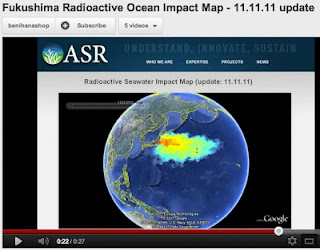It isn't clear from ASR's published material whether or not this model is influenced by the continuing entry of radioactive water into the ocean. It is fairly certain that Tepco and other monitoring agencies do not have anything that could be described as a clear idea as to how much radioactive water has gotten into circulation in the North Pacific, or how much water is continuing to make its way there.The issues I raised then had to do with irradiated water from the meltdowns that is making its way into North Pacific circulation patterns.
The issue raised about the results of these measurements taken in the North Central Pacific last summer appears to be different:
The Fukushima Daiichi nuclear disaster is far from over, as new reports explains that water samples taken nearly 400 miles off the coast of Japan in the Pacific Ocean are showing radiation levels of up to 1,000 times higher than previous readings. Presenting their findings at the recent Ocean Sciences Meeting in Salt Lake City, Ut., scientists continued to claim these severely elevated radiation levels are not a significant health or environmental threat.I'll speculate that the "presence of radioactive silver" in the findings is the result of airborne debris from one of the hydrogen-induced reactor explosions last spring.
Back in June 2011, a ship carrying scientists traveled off the eastern coast of Japan collecting water samples at distances of roughly 20 miles to 400 miles from the coast. Upon analysis, these samples were found to contain elevated levels of cesium-137 at ten to 1,000 times higher than levels detected before the Fukushima disaster, which is highly alarming.
Included in the detections was the presence of radioactive silver, which is an obvious product of melted control rods at the nuclear facility. The mainstream media is claiming that this silver is simply a result of nuclear fission, but the reality of the situation is that this silver is evidence of a complete core meltdown at the facility, which is obviously having widespread repercussions.
It is somewhat reassuring that there are indeed research ships containing scientists in the Northwest Pacific, "collecting water samples." It is distinctively less reassuring, that at the conference where these findings were announced, they were minimized:
Meanwhile, Hartmut Nies, an official from the International Atomic Energy Agency (IAEA), insists that all this radiation is not that big of a deal. He even went so far at the recent meeting to claim that "if it was not seawater, you could drink it without any problems," a completely absurd position that has no grounding in science.
As part of their misinformation campaign, IAEA officials and others compared the radioactive cesium and silver to the naturally-occurring, elemental potassium-40 found in seawater. This natural potassium, of course, is much different than the radioactive elements being emitted from Fukushima, as sea creatures have developed a natural tolerance for potassium-40.
Even those falsely claiming that all this radiation is completely harmless to humans are at least admitting that the findings are indicative that the Fukushima nuclear facility is still leaking radiation into the environment.

3 comments:
Thank you, Mr. Munger, for bringing up this important issue relevant to all Alaskans. I've seen many reports from governmental agencies claiming no harm from Fukushima fallout, denying the need for any testing. Why would one not measure the isotopes--it is a very simple process?
Clean green nuclear energy advocates benefit from the fact that isotopes cannot be seen, felt, or tasted. And the public relations is very misleading by failing to mention the real issue, which is the hazard of bio-magnification and internal exposure. When one passes by isotopes outside the body, exposure is brief and generally not much to worry about--the rule of time, distance, and concentration is in effect. The problem is, air and seaborne radiation accumulate up the food chain, and bio-concentate/bioaccumulate in the largest predators (depending on the type of food chain and type of isotope). Up here, that would be us and the bears.
http://e360.yale.edu/feature/radioactivity_in_the_ocean_diluted_but_far_from_harmless/2391/
http://www.montrealgazette.com/news/After+Fukushima+fish+tales/5994237/story.html
Why wouldn't we test our salmon? I would love to have some of the gentlemen from the IAEA and the NRC over to dinner. Since they seem so enamored, I might serve them some of their own cooking.
thanks, laato
Tell me why the halibut from Homer, Alaska has mushy chalky meat now? I'm scared the radiation is causing this new change. Does anyone have any new information about radiation levels in Alaska's waters? They sure are keeping a tight lid on the information.
Post a Comment